| |
|


FRIDAY, JULY 18 Temple Solel Shabbat at Beach


SATURDAY, AUGUST 2 Temple Emanu-El Joshua Nelson Concert


MON., SEPT. 29-THURS., OCT. 9


LETTER FROM JERUSALEM
Israel's national guessing game: Can Olmert last? If not, who will succeed him?
By Ira Sharkansky
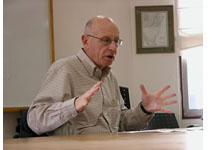 JERUSALEM—Ehud Olmert's problems have deepened, with accusations that he doubled-, tripled-, and quadrupled-billed for his overseas trips while Mayor of Jerusalem and Minister of Trade and Commerce. His lawyers and supporters assert that the violations are technical, the fault of bureaucrats, and trivial. Countering this are claims that Olmert's profits exceed US $100,000, that he managed the techniques employed, and used the money for family travel. JERUSALEM—Ehud Olmert's problems have deepened, with accusations that he doubled-, tripled-, and quadrupled-billed for his overseas trips while Mayor of Jerusalem and Minister of Trade and Commerce. His lawyers and supporters assert that the violations are technical, the fault of bureaucrats, and trivial. Countering this are claims that Olmert's profits exceed US $100,000, that he managed the techniques employed, and used the money for family travel.
We hear competing reports of a government that is not functioning alongside claims of business as usual. Some prophets predict that the prime minister will resign this month. Others say he will dig in, and take advantage of legal and political realities that make it difficult to carry him off against his will.
The legal and political work involved in all of this may not end quickly. Pending that, it is interesting to consider the personalities who are jostling to become the next prime minister.
The candidates in the Kadima Party are
- Tzipi Livni, currently serving as Foreign Minister, and who has served in ranking administrative and political positions for more than two decades that include service as Ministers of Justice, Immigrant Absorption, and Agriculture;
- Abraham Dicter, currently Minister of Public Security with responsibility for the police, and formerly the head of the General Security Agency (Shin Bet);
- Meir Shitrit, currently Minister of the Interior, who began his political career as a mayor, and has served in numerous ministerial positions including Justice, Transportation, Education, and Finance;
- Shaul Mofaz, currently the Minister of Transportation and formerly commanding general of the IDF and then Minister of Defense.
The major candidate in the Labor Party is Defense Minister Ehud Barak. He served as commanding general of the IDF, and then a previous term as Defense Minister, and Prime Minister.
Benyamin (Bibi) Netanyahu is the leading candidate from Likud. His background includes service as Ambassador to the United Nations, Prime Minister, and Finance Minister.
Compare these folks to the candidates running for the American presidency. Neither of the Americans has any major administrative experience, and Obama has yet to serve a full term in a national position.
None of the above assures that Israel's government will function better than the American government. The head of government is only one factor in determining national fortunes. Arguably the national fortune is more important, and the American fortune dwarfs that of tiny Israel. Neighbors are also important. Israelis would be willing to trade the Arabs and Persians for the Canadians and Mexicans.
One can think of the comparative benefits of heroes or managers as national leaders.
No doubt that the public admires heroic promises to solve big problems. Think of the Kennedy and Johnson missions to deal with Communism in Vietnam, and George W. Bush's mission to settle the problems of evil and terror coming out of Iraq and Afghanistan.
Management is dull, and gives up the dream of peace or prosperity without blemish. On the positive side, it is less dangerous than heroism. Managers want to improve things, but "Do not make it worse" is a prime motto.
Israel benefits from the small size of its fortune. Neither current nor potential leaders propose to conquer or reform the enemies. Experience has put the emphasis on limited use of the military, and limited occupation of hostile territory.
Things are far from optimal. Hizbollah has rearmed, and Hamas is doing what it can to prepare for nasty things. Israel's threats against them may be enough to keep them quiet. Each has learned what the IDF can do.
Iran is another story. If an attack comes, we can hope that it is well managed. There has been a great deal of preparation, and extensive discussions of likely consequences.
Again this is a time to envy the Norwegians. They have both fortune and decent neighbors. As far as I know, heroism has not been part of the national character since the Vikings.
Sharkansky is professor emeritus of political science at Hebrew University


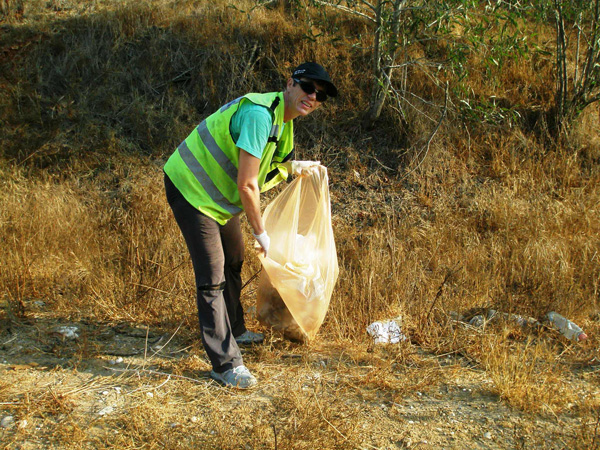
FROM THE GATES OF THE NEGEV
Sha'ar Hanegev bureau chief campaigns
to dispose of litter at Kibbutz Ruhama
By Ulla Hadar
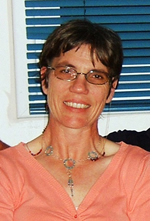 KIBBUTZ RUHAMA, ISRAEL--When something bothers me, I usually get upset and start moaning and complaining. Many different things can annoy me, but now that I bike a couple of times a week to the fitness center (26 kilometers), I notice all the garbage on both the sides of our kibbutz road. When you drive at a slower pace you see more. I hate when people use mother nature as their trash can. KIBBUTZ RUHAMA, ISRAEL--When something bothers me, I usually get upset and start moaning and complaining. Many different things can annoy me, but now that I bike a couple of times a week to the fitness center (26 kilometers), I notice all the garbage on both the sides of our kibbutz road. When you drive at a slower pace you see more. I hate when people use mother nature as their trash can.
Noticing all this garbage on my way, I thought to myself that this is not right. Then, I remembered what my dear husband always tells me, "either you will just stop complaining or if you are fed up, do something about it!”
So on Sunday morning, I got myself organized for a "tikkun olam" project of my own. Stocked with self-disposable gloves, plastic garbage bags, a reflective vest, water, and my bike I was on my way. My goal was to start to clean the mile road that goes from the main road into the kibbutz. My hope was to finish the whole distance in one day although the very hot and sunny weather would not enable me to work for many hours.
I had shared my idea with very few people because experience has taught me their reactions would be that I must have a screw loose and why on earth would I go do something like this?
But when I have my mind set on something I do not give up so easily – it must be that very stubborn nature of mine. I was convinced my decision was right; I could not have cared less what other people thought
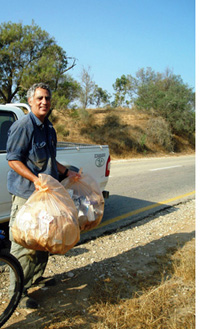 The beginning was the intersection of the main road and the kibbutz road and I worked my way back towards the kibbutz cleaning both sides of the road. I had many glances from the passing cars and several stopped to ask me if everything was okay. I guess seeing a woman collecting garbage on a road dragging a bicycle after her is probably an unusual picture. It was nice to get some reactions though. The beginning was the intersection of the main road and the kibbutz road and I worked my way back towards the kibbutz cleaning both sides of the road. I had many glances from the passing cars and several stopped to ask me if everything was okay. I guess seeing a woman collecting garbage on a road dragging a bicycle after her is probably an unusual picture. It was nice to get some reactions though.
I had not planned what to do with all the bags I collected, but I knew I could always find someone to help me move them away afterwards. Very pleasant it was when two different vehicles stopped and asked me if they could help me dispose of the bags. My thanks to Rami Polaco, head of the unirrigated fields in Kibbutz Ruhama and to Izhar Vardi (at left), who is part of the same team.
The work was completed after three hours: nine huge plastic bags full of trash, a close encounter with hundreds of Styrofoam cups, yogurt cups, plastic bottles, candy wrappers, snack bags and the other assorted debris of “civilization.”
I feel some strain in my back from all the bending over but it will pass and the exercise is recommended to anyone who might feel like following in my footstep.
Hadar, Sha'ar Hanegev bureau chief, may be contacted at hadaru@sandiegojewishworld.com


LETTERS
Seeks memoirs from North Americans who volunteered during Israel's Six-Day War
Editor, San Diego Jewish World
I am compiling memoirs for a book about volunteers to Israel who travelled there in June 1967 to help. Many Jews and Gentiles participated, to help as nurses, drivers, farm workers, etc. Time is passing quickly, and the record must be compiled before it is lost. If any of your readers are among
those who went to help, would they please contact me at VolunteerIsrael1967@gmail.com. If they are acquainted with someone who went, would they kindly forward this information to them.
Michael Zimmerman
Chicago, Illinois
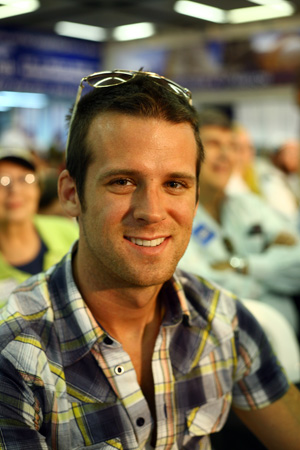 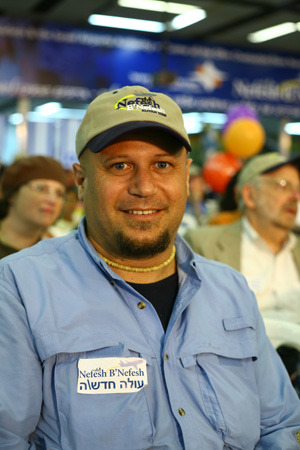
)
Yesawich, Rhodes make aliyah from San Diego
Editor, San Diego Jewish World
I know the story about Avi Yesawich already ran but I finally have the pictures from the July 10th arrival.
Please find photos attached of Avi Yesawich, 24, who is moving from San Diego to Kibbutz Naan and will be joining the army with Garin Tzabar, and David Rhodes, 43,who is moving from San Diego to Tel Aviv
Both of these gentlemen were on the flight with 220 other olim and are part of the 2000 being brought to Israel this summer under the auspices of Nefesh B'Nefesh.
Dena Wimpfheimer
Nefesh b' Nefesh
New York, New York
Article on Merchant Marine wins plaudits
Editor, San Diego Jewish World
Great article, as always so well written. Thanks for taking time, seeking research and talent to put the scraps together on behalf of the Combat Merchant Marine Veterans of WWII. I learned more information about the players from your article. It is a fine website. Loaded. Warmest regards,
Sheldon Merel,
Cantor Emeritus, Congregation Beth Israel
San Diego, California



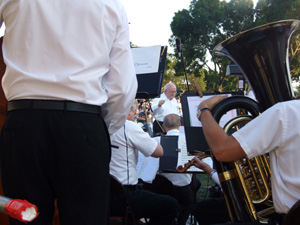 
THE JEWISH CITIZEN
TICO concert brings community together
By Donald H. Harrison
 SAN DIEGO—A concert in a park under a summer’s evening sky is about the music of course, but it also is about meeting neighbors, seeing their children and grandchildren, and even petting their dogs. It is about people who almost never seem to emerge from their homes looking each other in the eye, smiling at the words and rhythms of familiar songs and melodies, and feeling a sense of community. SAN DIEGO—A concert in a park under a summer’s evening sky is about the music of course, but it also is about meeting neighbors, seeing their children and grandchildren, and even petting their dogs. It is about people who almost never seem to emerge from their homes looking each other in the eye, smiling at the words and rhythms of familiar songs and melodies, and feeling a sense of community.
On Sunday evening, July 13, the catalyst for such an event in the Allied Gardens section of San Diego was the Tifereth Israel Community Orchestra (TICO), a 65-member volunteer orchestra whose members, noted the emcee, “are of all faiths.” There were a sprinking of Jews associated with the orchestra, to be sure, including conductor David Amos and Rabbi Leonard Rosenthal, who is one of the violinists. However, the orchestra’s members are of many religions and many ethnic backgrounds—bound together by a love of music and performance.
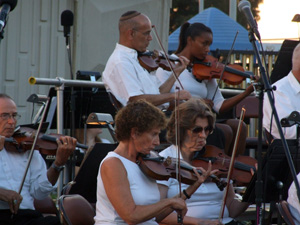 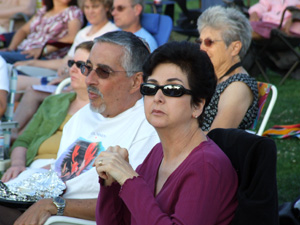
Allied Gardens is one of the older subdivisions in San Diego, built immediately after World War II in the rush to provide housing for soldiers and sailors who had fought for the allies. In one of the evening’s selections, Amos led the orchestra through the “Armed Forces Medley” arranged by Bob Lowden, after asking veterans who had served in the military to stand when they heard the anthem of their respective services—Army, Coast Guard, Air Force, Marines and Navy. There may have been more sailors, but the Marines cheered louder, probably to no one’s surprise.
Allied Gardens sends representatives to the Navajo Town Council, one of San Diego’s easternmost representative community organizations that also includes representatives from the nearby communities of San Carlos, Del Cerro, and Grantville. The latter community was named after America’s 18th President Ulysses S. Grant, whose son Ulysses S. Grant Jr., was an important figure in San Diego during the early 1900s.
Patriotic tunes—like John Philip Sousa’s “The Stars and Stripes Forever” and E.E. Bagley’s “National Emblem March” were mixed with some lighter works by classical composers including “Polonaise from Eugene Onegin” by P.I Tchaikowsky and “Tritch-Tratch Polka Op. 214” by Johann Strauss. Show tunes played during the concert focused included music from Guys and Dolls, Man of La Mancha, Beauty and the Beast, The Sound of Music, Mary Poppins and Les Misrables. Vocals arranged by Shelly Cohen featured the singing of Victoria Robertson, Joe Pechota and Garrett Harris.
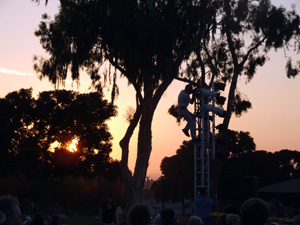 
The “Pops in the Park” free concert at the Allied Gardens Recreation Center officially began at 7 p.m. but many people came earlier in the afternoon with picnic baskets, blankets, low beach chairs and their dogs, all of whom seemed to enjoy the music. Organizers estimated the size of the crowd, not including the dogs, at 1,500.
At tents set up alongside the makeshift stage, one could purchase hot drinks (always a treat once the sun goes down in Southern California and the temperatures drop precipitously) , and popcorn or contribute to various causes, including a fund to assure other concerts and community events. Not unlike a church offering, concert goers placed money—usually of the folding variety—into buckets that ushers circulated through the crowd.
Amos had competition from a number of children, who were thrilled by the beat of the music—including my one-year-old grandson, Sky, who jumped up and down with every beat, a happy smile on his face, as his older brother Shor, 7, closely supervised him.
Within the crowd I saw many acquaintances from both Conservative Tifereth Israel Synagogue of the San Carlos area and Reform Temple Emanu-El of the Del Cerro area , including the latter congregation’s rabbi and rebbetzin, Martin and Anita Lawson.
A dog named Josie wandered over to our blanket and introduced herself.


REFLECTIONS
Jean Isaacs: Generous spirit opens doors
By Sheila Orysiek
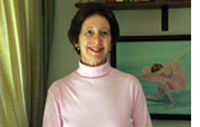 SAN DIEGO—Blessed are they who dance in a place made specifically for them and for the art they grace. Such a place is called, well, what else? - “The Dance Place.” SAN DIEGO—Blessed are they who dance in a place made specifically for them and for the art they grace. Such a place is called, well, what else? - “The Dance Place.”
In August of 2006, I attended the grand opening of what had been the Naval Training Center on Pt. Loma, and was now being developed into spaces specifically designed to house the needs of various arts entities, including dance. Since dance is a spatial art form - takes up space - in all three dimensions - it needs and has difficulty finding adequate facilities. These necessities also include a responsive floor, ceiling height, good light, adequate acoustics, wall space for mirrors and barres, unencumbered floor space, and good ventilation. In the normal stock of urban rental property these requisites are exceedingly difficult to fulfill. Turning the historic buildings on this site into accommodations for dance, was a miracle to the dance community of this city.
Subsequently, three long time resident dance companies in San Diego moved in. Another building is planned to become a performing arts theater, but until then and for work shops and other works in progress, studio performances are often presented. This gives the audience a wonderful opportunity to view an art form that all too often is only seen at a distance. What is lost in the magic of a proscenium venue is gained by proximity - which is how dance began in the mists of time.
Jean Isaacs San Diego Dance Theater put out a call for choreographers to showcase their work in two performances on July 12, 2008; interestingly modern dancer/choreographer Isaacs included four pieces utilizing ballet dancers and classical technique. The first three pieces were choreographed by Natalie Cook: Closing Time, Peaceful Sleep and You’re Late Again. Each dance was exceedingly short - by necessity - to fit into the time allotted for the program as a whole.
The dancers - Katie Critchlow, Marilyn Leider, Natalie Cook, Deby Gil, Gerardo Gil - were certainly up to the task and while expressive, the choreography didn’t have the time it needed for full development. You’re Late Again - a tango - didn’t “take off” - I wanted them to let go and tango. But it remains a question as to whether this didn’t happen because of the lack of time allowed. Perhaps Cook might have been better served to have presented only two works - and thus shown more of each.
Cook was inspired in her most successful piece Peaceful Sleep by the music of a lifelong friend, Jeffrey Stein, a local San Diego composer, a member of the Jewish community, who died a few months ago. This dance was created in his memory to his music. Peaceful Sleep was shortened from eleven minutes to two. It speaks well of what was shown that I wanted to see more.
When dance - ballet - is performed so close to its audience, as much a part of the ballet world as I have been, it is shocking to see the length to which a pared down body has been taken. There is a point at which the eye of the observer is jarred by ribs, collar bones and stringy legs, all too visible even through a costume. It’s unhealthy - it’s unnecessary. Ballet could learn from modern dance that a body needs some substance; ribs aren’t that attractive.
Homage to Susana Linke, choreographed by Isaacs, immediately showed the stark contrast between the sister dance forms: modern dance and ballet. The weight is used differently, the center core is lower and the body shape produced is strikingly different. Nuance and effect, are miles apart; but interesting miles. This piece for four women spent a deal of time walking the square of the studio space emphatically emphasizing pumping arms and firmly planted feet taking possession of the “road ahead.” The square was marked off and they owned it.
The next fives pieces were created by choreographers of varying degrees of experience and success; this is not a negative statement, but to be expected in a showcase giving opportunity to budding talent. Everyone has to start somewhere. Anjanette Maraya-Ramey’s piece (untitled) flowed well, with a single dancer, Vivana Alcazar, keeping up the energy.
Young choreographer, Rayna Stohl, from a company which focuses on teenage talent, made a good start using ten dancers, moving them around to cover available space, but occasionally fell into the temptation of having the dance patterns look more like a dance class - everyone lining up to go down the diagonal - than a performance piece. However, it’s a good start - and she certainly deserves encouragement.
For See You Somewhere choreographer Miriam Sach chose for her music “Dark Eyes” (Ochi Chernaya) music but her dance needed to get more into the flow of that irresistible music - this is another piece that seemed like a taste rather than a meal. Vivianna Alcazar’s Seven had lots of interesting movement, attention to detail, good interaction between her dancers - Minaqua McPherson and Anjanette Maraya-Ramey - as well as when they danced alone. I felt no hesitation in her creative abilities.
The highlight of the evening was a marriage of two people and two dance forms: gifted modern dance choreographer, Isaacs, and gifted ballet dancer, Bernadette Torres. It was called: Relish and Wanderlust - but by any name it was splendid. Torres is a tall leggy dancer (slender but not alarmingly so) whose technical abilities are on another level entirely. Ease of execution, command of her space and body, allows her to seamlessly fulfill the choreography and then some. We got to see how a ballet trained body, in pointe shoes, can take on modern dance and yet remain classical at its core. While some elements were rather gymnastic in shape, the dance element was not sacrificed. Ballet has profited from the talents of modern dance choreographers. I don’t know how much Isaacs has created for ballet, but she should do more.
Another Isaacs’ piece (with Minaqua McPherson), Vaudville Trip, was a fine finalé using the music “Slavic Soul Party” - by a Slavic Band - which actually sounded a great deal like Klezmer. Three dancers: Minaqua McPherson, Amy Rasdal, Marlo Stoutenberg - wore trench coats over flesh colored tights and leotards, flashed opening and closing the coats, parodying the “now you see it - now you don’t” aspect of the “flasher.” The piece was clever and spiced with humor.
Isaacs is to be applauded for her generosity of spirit in giving other talent - both experienced and not so - a venue to show, to learn by doing, and to profit from her much more skilled hand. All too often the answer is “no” to those who seek entry. How can they learn - how can dance grow - if those who control the space available aren’t willing to encourage others? And I further applaud Isaacs for extending that generosity of spirit to include another dance form - ballet - into her modern dance home.


ADVENTURES IN SAN DIEGO JEWISH HISTORY
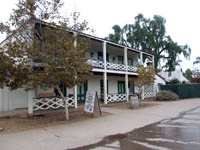
Robinson-Rose House
|
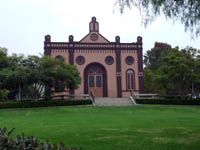
Old Temple Beth Israel |
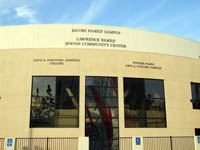
Lawrence Family JCC |
Editor's Note: We are reprinting news articles that appeared in back issues of various San Diego Jewish newspapers. You may access an index of the headlines of those articles by clicking here. You may also use the Google search program on our home page or on the headline index page to search for keywords or names.
Week At Camp In Palomar Mountain
From Southwestern Jewish Press, July 24, 1947, page 1
Thirty campers have reservations to date for Camp Palomar. The campers, seven counselors and a nurse, will leave from the Temple Center, Monday, July 28, at 9:30 a.m. for a week in the Palomar Mountains. Nestled in Doane Valley at the crest of Mt. Palomar, 3 ½ miles from the observatory, surrounded by towering fir trees and majestic peaks Camp Palomar is magnificently located. The camp is operated on a year-round basis by the City-County Camp Commission, under the direction of Edward Pumala and supervised by Charles Podorean, a trained counselor-teacher, employed by the Board of Education. The staff of the community center committee will be as follows:
Albert A. Hutler, Executive Director, UJF: Standford Brust; Volunteer Counsellor; Ben Haddock, Head Counsellor Day Camp; Mrs. G. Curtin, Nurse; Ruth Fiel, Counsellor Day Camp; Herbert Solomon, Vol. Jr. Counsellor; Edward Breitbard, Volunteer Counsellor; Estelle Addleson, Vol. counselor.
The campers who signed up on the first day of registration are:
Larry Becker, Bobbie Cherney, Arlene Cohen, Marcia Cohen, Jane Cohn, Morton Cohn Jr., Allan Friedman, Rochelle Goodrich, Heddie Grossman, Suzanne Hutler, Edward Naiman, Gary Naiman, Leonard Naiman, Larry Prager, David Ruskin, Irwin Shatzman, Steven Schulman, Douglas Scott, Michael Soule, Norman Starr, Paul Stein, Myrne Belle Wosk.
An experienced cook and a supervised kitchen to prepare the meals will assure your child of a balanced diet. Tent shacks barracks, showers, and sanitary facilities are such that the camper will be comfortable though roughing it. Hiking, nature study, sports, fishing, songfests, archery, crafts will be some of the may activities awaiting campers at Palomar.
Registration will close tomorrow at 5 p.m. Campers may be registered by calling F-0171.
Day Camp Proves Successful in S.D.
From Southwestern Jewish Press, July 24, 1947, page 3
Tomorrow the first “Day Camp” in San Diego operating a “Camp at Home’ on a five day week bass will conclude a successful five week period of activity with a party and exhibition for parents and friends at the Temple Center at 2:30 p.m., according to an announcement from the Community Center Committee of the United Jewish Fund>
Well over 50 children, five of whom were on “camperships” participated in the program. They learned to swim, ride, model with clay, sing camp songs, hike, and to play and work together. Trips were taken to the zoo, the Amphibious Base, North Island Naval Training Center, and the Marine Base. Highlight of the camp season was the trip to the Amphibious Base where the campers were taken for a boat ride in the bay and then ate “chow” with the sailors. The trip to the county fair will also be long remembered by the campers.
The overnight “campout” at Torrey Pines, the trip and lunch at the Naval Training Center, the riding lessons and the closing party are a fitting climax to an unprecedented five weeks.
The following assisted the camp staff, and to them is due much of the credit for the success of the “Day Camp.” Morris Douglas, Marshall Naiman, Max Rabinowitz,l Edward Breitbard, Mrs. Sam Bennett, Mrs. Ted Brav, Mrs. Ben Gordon, Mrs. Victor Schulman. Plans are now being made for a continuation of the program on an eight week basis next summer, and for a partial program in the fall.
USO-JWB Enjoys ‘Brunch’
From Southwestern Jewish Press, July 24, 1947, page 4
Sponsored by the USO-Jewish Welfare Board, a delicious brunch consisting of bagel, herring, sour cream, salad, cheese cake and coffee was enjoyed at the Temple center, Sunday. Joan Jacobson, Jean Gulko and Betty Shapiro assisted in serving. After the lunch, the group of servicemen and Junior Hostesses went to Balboa Park for a picnic. Some visited the zoo, while some played ball and other games. The highlight of the day’s fun was the serving of watermelon which proved to be a delightful treat!
In the evening, dancing was enjoyed at the Temple Center. During intermission, Sid Lubin, Musician First Class stationed at the Naval Air Station, entertained with several piano selections which were enthusiastically received. Refreshments were served by Miss Ethel Parnass.
On Sunday, July 27th, a beach party will be held at Del Mar. Servicemen and Junior Hostesses are invited to these very popular summer outings.
Lasker Lodge B.B.
From Southwestern Jewish Press, July 24, 1947, page 5
The steering committee for the Hillel Councilorship for San Diego State College met at Morrie Douglas’ home last week and discussed the constitution at great length and accepted the final draft. The students are showing a great deal of enthusiasm which bodes well for the future of the councillorship. Some time in September, after the fall semester commences, inaugural ceremonies will be held in an impressive program to be announced later.
On August 1st Lasker Lodge will make another in a series of presentations to the U.S. Naval Hospital, this time consisting of twelve radios and four automatic record players. Representing the Lodge will be President Morrie Douglas, Vice President Ed Breitbard and dave Block.
The softball team is doing very well in the face of pretty strong competition. The turnouts are good and the spirit is very high even though the muscular response is somewhat slow at times.
Meetings have been surprisingly well attended in spite of the usual summer let-down. This may be attributed to the interesting programs presented and to the lively discussions held at practically every meeting. Visitors are always welcome at the regular meetings held at the Lodge room, the Temple Center, on the second and fourth Mondays of each month.
At the last meeting Eddie Breitbard, Lasker Lodge representative of the southern California Council of B’nai B’rith, reported on the week end meeting for August 3rd at which time Lasker Lodge and its Auxiliary, Birdie Stodel, will be hosts to Council members and their wives. Reservations are coming in for the boat ride for Saturday evening, August 2nd, and for the no-host breakfast and luncheon on Sunday, August 3rd. Breakfast will be served at 8:30 and reservations for ll can be made by calling Dave Block at Main 0194, or Ed Breitbard at Franklin 3124. All members are invited to attend all affairs for this weekend.

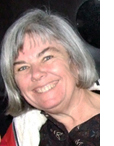 Nancy Harrison Nancy Harrison
cruise & tour specialist
(619) 265-0808


SAN DIEGO JEWISH WORLD THE WEEK IN REVIEW
Middle East
Iran's bad week: gas deal with French Total sours, missile test lacks credibility by Shoshana Bryen in Washington, D.C.
Shaliach tells fellow kibbutzniks about his goodwill assignment in Tulsa, Oklahoma by Ulla Hadar in Kibbutz Ruhama, Israel
G. I. Joe’s choices reshape the battlefield by Sheila Orysiek in San Diego
San Diego and the Nation
World War II-era Merchant Mariners seek compensation for lost G.I. Bill privileges by Donald H. Harrison in San Diego
Adventures in San Diego Jewish History
—July 17, 1947: Lasker Lodge B.B.
—July 17, 1947: Jewish Labor Com.
—July 17, 1947: Birdie Stodel B.B.
—July 17, 1947: Pioneer Women
Judaism
The wily machinations of the yetzer hara by Rabbi Baruch Lederman in San Diego
Sports
A bissel sports trivia with Bruce Lowitt in Clearwater, Florida
Judaism
We can judge a leader by his followers by Rabbi Leonard Rosenthal in San Diego
San Diego
Danny and Clyde... They lived a lot, and stayed friends since their school days by Donald H. Harrison in San Diego
Adventures in San Diego Jewish History
—July 10, 1947: J.C.R.A
—July 10, 1947: Birdie Stodel B.B.
—July 10, 1947: U.S.O.-J.W.B. Activities
—July 17, 1947: Palomar Camp Plans Completed
Arts
Falstaff a great fall guy in 'Merry Wives' by Carol Davis in San Diego
Famed director Sydney Pollack laughingly agreed to take direction from an amateur by George Falkowitz in Oceanside, California
Chapter 16 of Reluctant Martyr, a serialized novel by Sheila Orysiek in San Diego
Middle East
Negev mayors protest Olmert decision against fortifications along Gaza border by Ulla Hadar in Sderot, Israel
U.S.-Iraq withdrawal negotiations prompt posturing for both countries' electorates by Shoshana Bryen in Washington D.C.
San Diego
San Diego had his dream job and great weather, but Israel had his heart by Donald H. Harrison in San Diego
San Diego Jewish Trivia: Places by Evelyn Kooperman in San Diego
Adventures in San Diego Jewish History
—July 10, 1947: Fund Total Must Be Raised
—July 10, 1947: Registration Opened for Camp Palomar
—July 10, 1947: 'Campers' to Visit Training Center
—July 10, 1947: Lasker Lodge B.B.
Arts
Globe's Romeo and Juliet needs polish by Carol Davis in San Diego
Thursdays with the Songs of Hal Wingard of San Diego
—#51, Waiting for Anne Marie
—#42, Magdalena
—#184, Anne
Middle East
'Gabriel's Revelation' may alter Jewish, Christian concepts of interrelationships by Ira Sharkansky in Jerusalem
Australia
A Roundup of Jewish news in Australia by Garry Fabian in Melbourne
—My grandson's bar mitzvah—and mine
—Shtetl of Zhetl inspires prize-winning essay
—Rabbi Yitzchok Groner dies aged 83
—Jewish groups avoid Diaspora study
—Rabbis oppose euthanasia bill
—Community looks closely at Jewish education cost
—Foreign Affairs Dept. investigates tourist's fate
—Bug's scientific name honors Australian Jew
—Australians to lead at Yad Vashem conference
—Achiever off to Prague
—JLC gets a new home
—Maccabi's winning run continues
—Police called after spiteful football game
San Diego
Scholarly, easy-to-read work tells of San Diego places people are dying to get into by Donald H. Harrison
Adventures in San Diego Jewish History
—July 3, 1947: Jewish Labor Com
—July 3, 1947: Birdie Stodel B.B.
—July 3, 1947: Yo-Ma-Co
—July 3, 1947: Pioneer Women
Arts
All that ends well still can be a problem by Carol Davis in San Diego
Sports
Two Jews in starting All-Star Game lineup by Bruce Lowitt in Clearwater, Florida
Middle East
The cause of freedom, then and now by Shoshana Bryen in Washington, D.C.
Volunteers psychologically counsel people, repair houses in rocket-scarred regionby Ulla Hadar in Kibbutz Ruhama, Israel
San Diego
New Americans Museum celebrates some of this country's richest blessings by Donald H. Harrison in San Diego
Adventures in San Diego Jewish History
—July 3, 1947: Palomar Camp Will Be Site Of Outdoor Activities
—July 3, 1947: Representatives of Agencies Meet in Temple
—July 3, 1947: Day Camp is Popular For Many Children
—July 3, 1947: San Diego Prepares For Post-USO
Arts
Two Yiddish books to tickle the silly bone by Sheila Orysiek in San Diego
Middle East
—Stopping Iran's growing nuclear threat by U.S Congressman Bob Filner in San Diego
Environmentalism
—Sometimes 'brown' is better than 'green' by Sheila Orysiek in San Diego
San Diego
Governor Grille, a kosher meat restaurant, makes its debut at Chabad-University City by Donald H. Harrison in San Diego
Adventures in San Diego Jewish History
—June 26, 1947: Birdie Stodel B.B.
—June 26, 1947: Pioneer Women
—June 26, 1947: Jewish Labor Com.
—June 26, 1947: Jolly Sixteen
Arts
The Joker: from Catskills to Gotham City by Rabbi Simcha Weinstein in New York
Rose burdened with too many thorns by Cynthia Citron in Los Angeles
Link to previous editions
< BACK TO TOP
|
|

